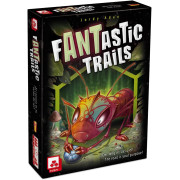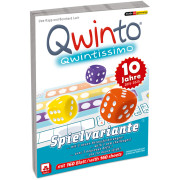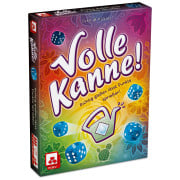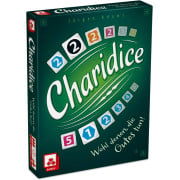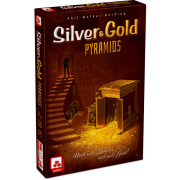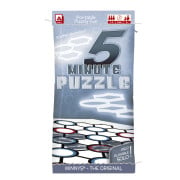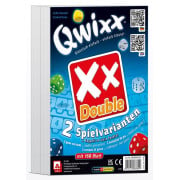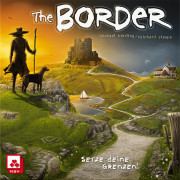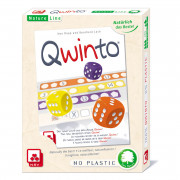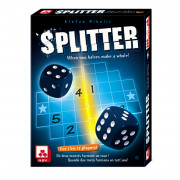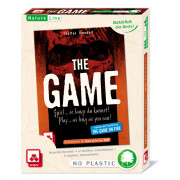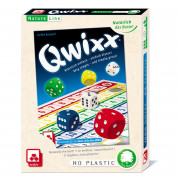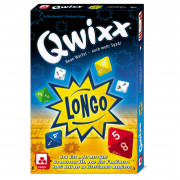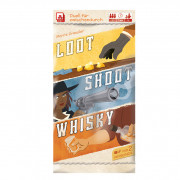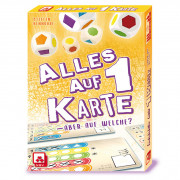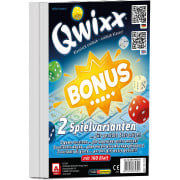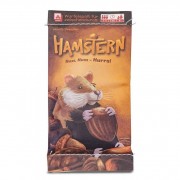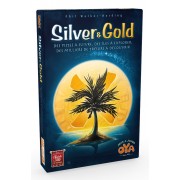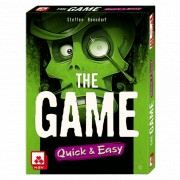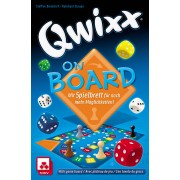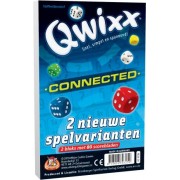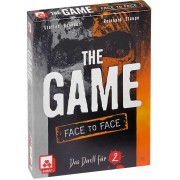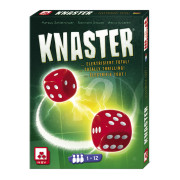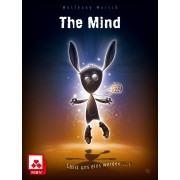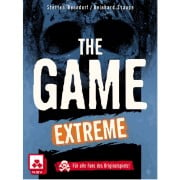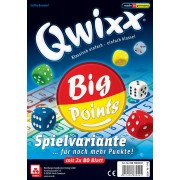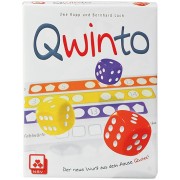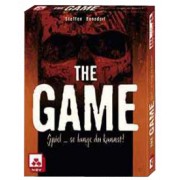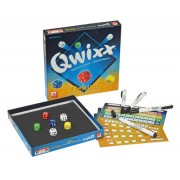Nürnberger Spielkarten
- Grid display
- List display
-
New
19,95 €
This forest is teeming with ants: over three rounds you uncover cards and enter numbers on your forest floor. Continuous number rows form long ant roads and bring points at the ...
- English, French, German, ...
- From 10 years old
- 1 to 4 player(s)
- less than 30mn
19,95 €
Vendu par Philibert
-
New
19,95 €
It sounds so simple: take a cube out of the pool, clack it on a second cube and put the sum of the two on your tableau. But choose wisely! Each row has its own rules. And not ev...
- French, English, German, ...
- From 8 years old
- 2 to 4 player(s)
- less than 30mn
19,95 €
Vendu par Philibert
-
24,95 €
10 years already! A perfect occasion to celebrate the success of The Game in style.
- French, English, Polish, ...
- From 8 years old
- 1 to 5 player(s)
- less than 30mn
24,95 €
Vendu par Philibert
-
6,50 €
Qwintissimo is an expansion block for the game Qwinto.
- English, French, Polish, ...
- From 8 years old
- 2 to 5 player(s)
- less than 30mn
6,50 €
Vendu par Philibert
-
Qwixx Connected - Blocs supplémentaires
6,50 €
2 extra score pads for Qwixx Connected.
- English, French, German, ...
6,50 €
Vendu par Philibert
-
11,95 €
Manage your random water supply to satisfy your plants.
- English, French, Polish, ...
- From 8 years old
- 1 to 4 player(s)
- less than 30mn
11,95 €
Vendu par Philibert
-
12,95 €
Charidice is a fast-paced roll & write game in which you can win by earning points or by giving points to your opponents!
- German
- From 8 years old
- 2 to 4 player(s)
- less than 30mn
12,95 €
Vendu par Philibert
-
6,50 €
Qwixx - X-Change Zusatzblöcke is a variation of the Qwixx game featuring a completely new mechanic: Nine squares are added to the four usual colored rows.
6,50 €
Vendu par Philibert
-
11,95 €
Arrange your drawers in the best way possible.
- English, French, German, ...
- From 8 years old
- 1 to 6 player(s)
- less than 30mn
11,95 €
Vendu par Philibert
-
14,95 €
Silver & Gold Pyramids takes you on a playful expedition into the world of the pyramids.
- German
- From 8 years old
- 2 to 4 player(s)
- less than 30mn
14,95 €
Vendu par Philibert
-
4,95 €
Pack shapes into your grid as tightly as possible, losing points for open spaces.
- German
- From 8 years old
- 1 to 6 player(s)
- less than 30mn
4,95 €
Vendu par Philibert
-
13,95 €
The game Illusion but 100% plastic-free and made of durable materials.
- German
- From 8 years old
- 2 to 4 player(s)
- less than 30mn
13,95 €
Vendu par Philibert
-
5,95 €
Two new additional variants appear in the QWIXX universe and bring new number fields for more tactics and more points.
- German
- From 8 years old
- 2 to 5 player(s)
5,95 €
Vendu par Philibert
-
19,95 €
Mark off all the border spaces to score the area you've just surrounded.
- English
- From 8 years old
- 2 to 4 player(s)
- less than 30mn
19,95 €
Vendu par Philibert
-
13,95 €
As the third part of our award-winning dice game hits Qwixx and Qwinto, Qwantum joins the new NATURELINE. Just as simple. Just as exciting. And of course without waiting times.
- English, French, German, ...
- From 8 years old
- 2 to 4 player(s)
- less than 30mn
13,95 €
Vendu par Philibert
-
Qwantum - Blocs Supplémentaires
4,95 €
2x replacement blocks with a total of 160 sheets for the card game Qwantum.
4,95 €
Vendu par Philibert
-
Qwixx NatureLine - Blocs Supplémentaires
6,95 €
Replacement blocks for the popular dice game Qwixx and Qwixx NatureLine!
6,95 €
Vendu par Philibert
-
4,50 €
Vendu par Philibert
-
Qwixx Longo - Blocs supplémentaires
6,50 €
This pack contains 2 extra score blocks for Qwixx Longo.
- German
- From 8 years old
- 2 to 5 player(s)
- less than 30mn
6,50 €
Vendu par Philibert
-
Qwixx on Board - Blocs supplémentaires
4,50 €
This pack contains 2 extra sheet for Qwixx on Board.
- German
- From 8 years old
- 2 to 5 player(s)
- less than 30mn
4,50 €
Vendu par Philibert
-
14,50 €
The game idea and graphics have remained the same, but the Natureline series guarantees plastic-free packaged games developed with sustainable materials.
- French, English, German
- From 8 years old
- 2 to 5 player(s)
- less than 30mn
14,50 €
Vendu par Philibert
-
11,95 €
Place numbers in mirrored spaces to create scoring groups.
- German
- From 8 years old
- 1 to 10 player(s)
- less than 30mn
11,95 €
Vendu par Philibert
-
13,95 €
Like all good classics, The Game has its NatureLine version. Still the same exciting challenge, but now 100% plastic-free.
- English, French, German
- From 8 years old
- 1 to 5 player(s)
- less than 30mn
13,95 €
Vendu par Philibert
-
13,95 €
The game idea and graphics have remained the same, but the Natureline series guarantees plastic-free packaged games developed with sustainable materials.
- French, English, German
- From 8 years old
- 2 to 5 player(s)
- less than 30mn
13,95 €
Vendu par Philibert
-
17,95 €
The world of Qwixx grows and offers with the new version QWIXX LONGO not only a longer score sheet and 8-sided dice, also two unique lucky numbers per player expand the fun of t...
- French, English, German, ...
- From 8 years old
- 2 to 5 player(s)
- less than 30mn
17,95 €
Vendu par Philibert
-
4,95 €
In Go for Gold, you and other players explore an island with temples and treasures, trying to get more loot than anyone else.
- German
- From 8 years old
- 2 to 4 player(s)
- less than 30mn
4,95 €
Vendu par Philibert
-
Red price
4,95 €
Outsmart your opponent and emerge victorious in this two-person saloon brawl.
- German
- From 8 years old
- 2 player(s)
- less than 30mn
4,95 €
Vendu par Philibert
-
13,95 €
Auf 1 Karte Auf is a game of Roll and Write in which players must fill the lines with the colors of the dice launched, but only one card at a time.
- German
- From 8 years old
- 2 to 4 player(s)
- less than 30mn
13,95 €
Vendu par Philibert
-
5,50 €
Qwixx Bonus - Zusatzblöcke contains two blocks of two additional variants for the famous German roll and write game Qwixx.
- French, English, German
- From 8 years old
- 2 to 5 player(s)
- less than 30mn
5,50 €
Vendu par Philibert
-
4,95 €
Bevor der Winter kommt, müssen genügend Vorräte gesammelt werden. Doch nur gefüllte Kammern sorgen für einen vollen Bauch und fette Punkte.
- German
- From 8 years old
- 2 to 6 player(s)
- less than 30mn
4,95 €
Vendu par Philibert
-
17,95 €
Distant islands, golden treasures - who hasn't dreamed of them?! And in this great family game it's all there. And even more!
- French
- From 8 years old
- 2 to 4 player(s)
- less than 30mn
17,95 €
Vendu par Philibert
-
5,50 €
Two blocks of two additional variants for the Qwixx game
- German
- From 8 years old
- 2 to 5 player(s)
- less than 30mn
5,50 €
Vendu par Philibert
-
11,95 €
The Game - Quick & Easy is a variation of the popular cooperative card game. The game consists of 50 cards, with cards of five suits numbered from 1 to 10 in each suit.
- German
- From 10 years old
- 2 to 5 player(s)
- less than 30mn
11,95 €
Vendu par Philibert
-
13,50 €
Vendu par Philibert
-
14,95 €
Qwixx On Board features rules identical to Qwixx, with the addition of a game board in which players want to move their pawn forward, occupy spaces, tactically cross out numbers...
- German
- From 8 years old
- 2 to 5 player(s)
- less than 30mn
14,95 €
Vendu par Philibert
-
4,95 €
Qwixx - Connected consists of two new scorepads that provide twists on the normal way of playing Qwixx.
- German
- From 8 years old
- 2 to 5 player(s)
- less than 30mn
4,95 €
Vendu par Philibert
-
11,95 €
Totally simple, exciting, with no waiting times and also awward-winning (Spiel des Jahres 2007 - does it need more introduction?), Knister is a quick and smart roll-and-write ki...
- English, French, German, ...
- From 8 years old
- 0 to 10 player(s)
- less than 30mn
11,95 €
Vendu par Philibert
-
13,95 €
Distant islands, golden treasures - who hasn't dreamed of them?! And in this great family game it's all there. And even more!
- German
- From 8 years old
- 2 to 4 player(s)
- less than 30mn
13,95 €
Vendu par Philibert
-
11,95 €
No more collaboration! You and your opponent with each a pickaxe to exhaust.
- German
- From 8 years old
- 2 player(s)
- less than 30mn
11,95 €
Vendu par Philibert
-
11,95 €
Everyone can play Knaster at the same time; all you need is a score sheet and ears to hear which number is being rolled on two dice.
- English, Italian, German, ...
- From 8 years old
- 0 to 10 player(s)
- less than 30mn
11,95 €
Vendu par Philibert
-
11,95 €
Ohanami is a draft and collection game with 120 cards, each containing one of the four symbols. Players have 3 rounds to score as many points as possible.
- German
- From 8 years old
- 2 to 4 player(s)
- less than 30mn
11,95 €
Vendu par Philibert
-
5,50 €
2 extra scorepads for Qwixx XL, for a total of 160 individual sheets.
- German
5,50 €
Vendu par Philibert
-
11,95 €
The Mind is more than just a game. It's an experiment, a journey, a team experience in which you can't exchange information, yet will become one to defeat all the levels of the ...
- German
- From 8 years old
- 2 to 4 player(s)
- less than 30mn
11,95 €
Vendu par Philibert
-
11,95 €
If you thought to master "The Game", the game thought of you ...
- German
- From 8 years old
- 1 to 5 player(s)
- less than 30mn
11,95 €
Vendu par Philibert
-
5,50 €
Qwixx: Big Points is an expansion for Qwixx that consists of two 80-page scorepads that provide a new way to score big points.
- German
5,50 €
Vendu par Philibert
-
11,95 €
Qwinto revisits the Qwixx game, but in a faster and more rhythmic version. Players play at the same time using the same dice result to fill their grids.
- German
- From 8 years old
- 2 to 6 player(s)
- less than 30mn
11,95 €
Vendu par Philibert
-
12,50 €
All players together must manage to put all the cards on 4 piles: 2 up, 2 down.
- German
- From 8 years old
- 1 to 5 player(s)
- less than 30mn
12,50 €
Vendu par Philibert
-
21,95 €
Deluxe version of QWIXX with erasable tables. Try to check the highest number of digits in the four color rows of your card. The player counting the most points at the end of th...
- French, English, German
- From 8 years old
- 2 to 5 player(s)
- less than 30mn
21,95 €
Vendu par Philibert
Copyright © 2025 www.philibertnet.com Legals - Privacy Policy - Cookie Preferences - Sitemap

